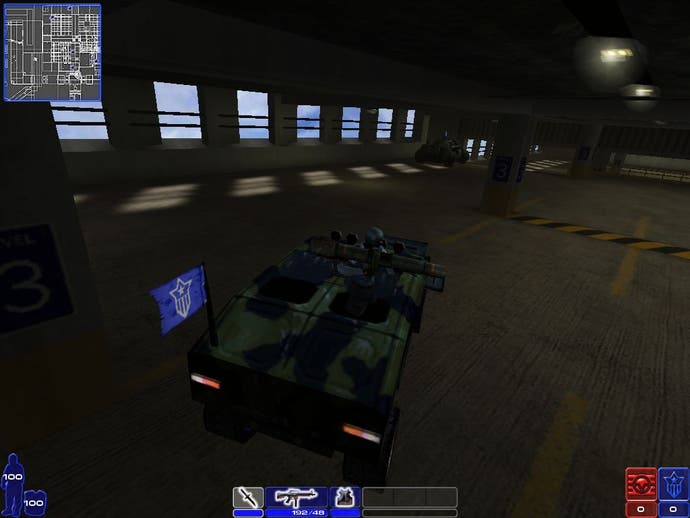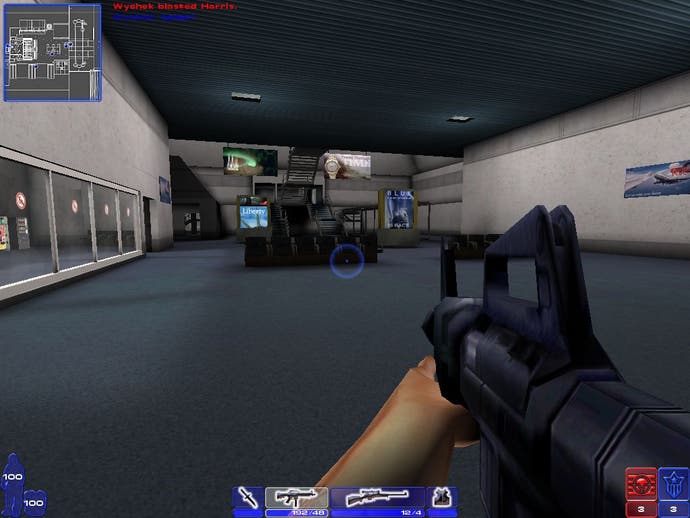Colin Macdonald of Rage - Part One
Interview - we talk to Mobile Forces' producer about the game's design, engine and development team
While the world isn't exactly short of online-focused action games at the moment, one of the more interesting efforts we've come across lately is Mobile Forces. Mixing Unreal Tournament style on foot action with a range of driveable vehicles and vast sprawling maps, it's certainly a nice change from your run-of-the-mill Counter-Strike clone. With the game now nearing release, we caught up with producer Colin Macdonald to find out more...

Mobilising
A veteran of the Grand Theft Auto 2 development team, as well as ports of Lemmings and Prince of Persia and "about a decade's worth of other stuff that isn't as good to name-drop", Colin is now heading up work on Mobile Forces at Rage's Dundee studio. "The bulk of the team behind Mobile Forces came together when DMA Design was closed down in Dundee, so we've got the two level designers from GTA and GTA2, programmers from Silicon Valley and GTA, artists from Tanktics, Wild Metal Country and Lemmings. And then joining us subsequently has been a programmer from the EA Formula 1 games and an artist from Strikeforce. All in all, a pretty well rounded lot! Our physics programmer is the same guy who did the groundbreaking work on Wild Metal Country, and it'd be wrong of me not to say that the GTA history of many didn't influence decisions about running people over." As you would expect coming from a team with that kind of background, the focus in Mobile Forces is very much on the gameplay and fast-paced action. "It's not about simulated realism, or a feeble storyline, or pushing more polys than anyone else, it's about fun. It's based on Unreal technology, with some of the next generation bits of tech that Epic have only just developed merged in there, and the main addition of vehicles. But not just any vehicles, as you've already noticed - stonking, fun, properly playable vehicles. Oh, and there's all that other normal gamey stuff that everyone else has - a variety of weapons, game types, levels etc."

Technology
Working with the Unreal technology has "been a pretty mixed bag" for Colin and his team. "Given the size of the team here, an off the shelf engine was an essential to get us up and running quickly - it gives you something you can see on screen within days, not months, and it gives you a set of tools that are fairly usable." "The disadvantages are cost (although the alternative of writing your own obviously has a significant cost as well) and the necessarily generic nature of licensed engines - it's been developed to cater for a number of different teams, doing a variety of different projects, so there's no way it can excel at every single thing." Timing was also an issue. "The way we've used the Unreal engine has been pretty unique - most teams in the past have taken a version of the engine and then modified it to suit their needs. We had a little problem from the start - the date we were committed to hitting (and still are!) was going to be over two years from when Unreal Tournament came out, which is a long time in gaming technology. But the next generation engine wasn't going to be finished until long after! So the best route for us was to base our game on the latest UT stuff and, as we went along, integrate anything that was cool enough and stable enough from the next gen codebase. Which is how we've got such lovely sweeping landscapes, but still some of the legacy restrictions of UT. And then on top of all that has come modifications done in-house, such as our own particle system."

Loaded
Aside from the inclusion of vehicles, at first sight Mobile Forces looks a lot like a combination of Unreal Tournament and Counter-Strike. "In the past I'd probably have thought of the thousands of hours put into making things as far away from UT as possible", Colin told us when we asked him about this. "But at the end of the day, it doesn't matter what we've done, or how we've done it, it's the end result that matters. And if we've got a game that bears a resemblance to Counter Strike, there's not a lot I can argue about!" "The majority of the guys here had never worked on a first person shooter before (although they were certainly playing them enough to count as a full time job), so we knew we couldn't exactly expect to go breaking new boundaries with the genre. What we could do though was look at what was popular and aim for that market, but in our own way. So although we've got contemporary weapons as Counter Strike does, we don't have realistic damage as we have more fun with lasting gun battles. Similarly with the loadout stuff, it was realising we didn't want the magically spawning weapons of UT or the hassle of having to save up money to buy weapons, so we came up with something in between." One niggle we had with the beta version of Mobile Forces we've been playing for the last few weeks is that you have to go through this weapons loadout screen every time you respawn. "It's something we've experimented with, but so far we've not found a solution that works better than the current system", Colin admitted. "We didn't want to force people into the rigid classes of Team Fortress, we wanted them to make a conscious decision about whether speed, or armour, or weaponry was important. When we had a really simple system just for selecting your most recent selection, people never experimented with the weapons - they went for the easy route of whatever they had last, so we are consciously forcing people to select weapons as it means they'll experiment with all the different combinations."

Balancing Act
Of course, Mobile Forces isn't the first game to combine first person action and driveable vehicles, but previous attempts have been decidely hit and miss. We mentioned Codename Eagle as one example of a game that didn't quite get the mix right, and apparently it's one that Rage have noticed as well. "Codename Eagle was actually a big influence in itself", Colin revealed. "We saw a great game in there, covered up by weak design, bugs and lack of polish. Multiplayer Codename Eagle is a blast, but play single player and it's hard to not feel sorry about such a wasted opportunity." One of the biggest problems in creating this kind of hybrid game is getting the right balance, not only amongst the various weapons but between on foot and in vehicle action as well. "As anyone who's ever even tinkered with a mod before knows, you can have the best intentions for a game about balances, numbers and strengths of things, but when you put it all together, it often just doesn't work." "So numbers are played around with in almost every new version, extra features going in sometimes improve an already existing feature, sometimes not. And then eventually, through lots of testing, hard work, and a little bit of luck, things start balancing and you get people having fun with the game. From my point of view, the best thing I can see is when the team sits and plays the game at lunchtime; not from a scientific, testing point of view, but just because it's fun." Tomorrow we'll take a look at how that testing has been going, as well as talking to Colin about some of the things that Rage have been tweaking since the demo was released, and what kind of post-release support we can expect for the game.
-
Mobile Forces interview - Part Two







